Impressions from French Polynesia
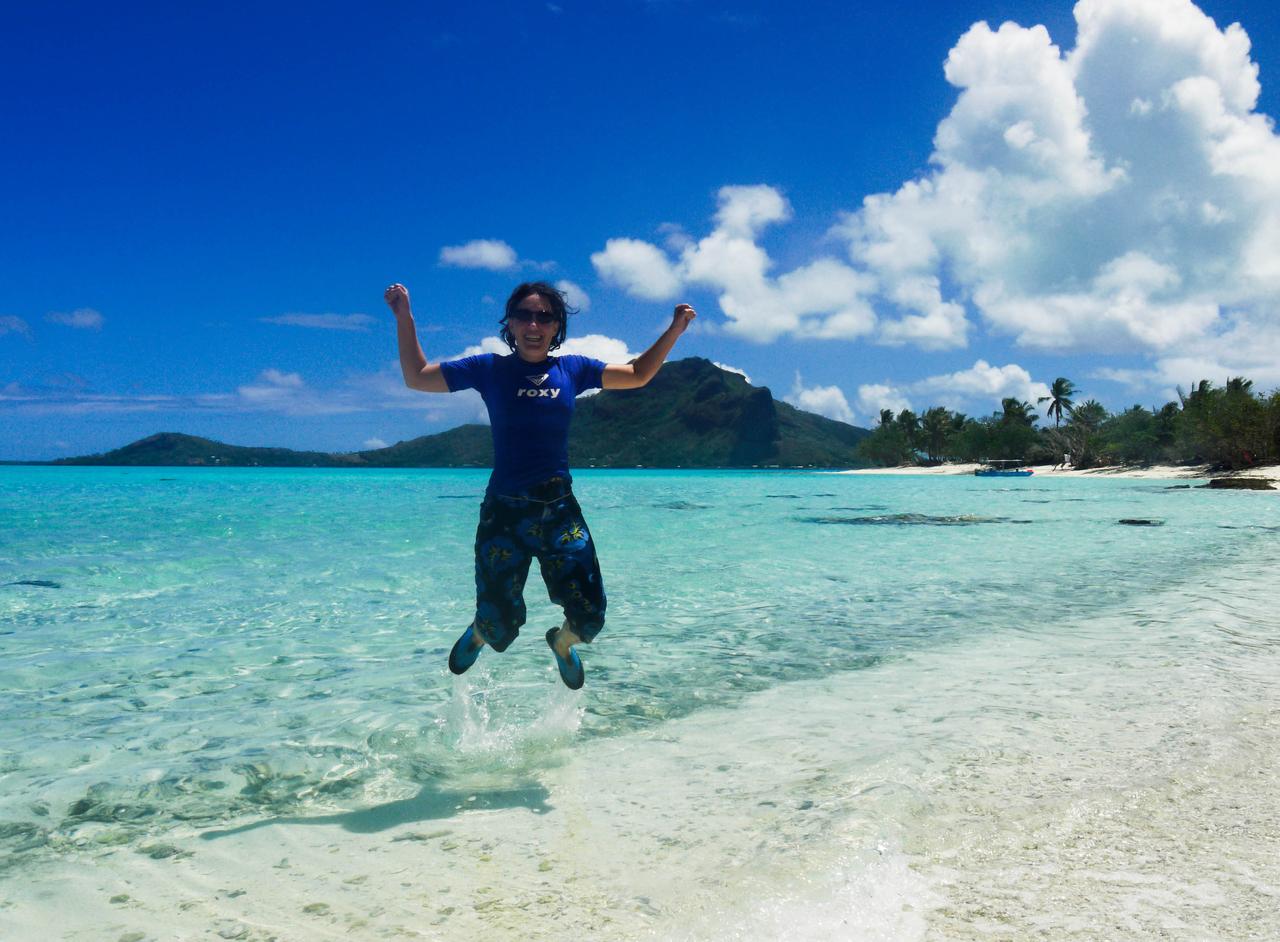 Maupiti!
Maupiti!
“Paradise”
French Polynesia spends a lot of effort marketing the South Pacific paradise image, first bestowed upon it by early western visitors - from Bougainville and Cook, to Gauguin and Mellville, to Michener.
So is it paradise? Of course not.
Tropical islands in general make poor candidates for paradise. Necessities can be scarce, and conveniences generally have to be imported. The heat is oppressive, an army of biting insects stands ready to eat you alive, and the next devastating cyclone is just around the corner. But if you don’t mind any of that, then sure, tropical islands are pretty much perfect.
French Polynesia is one of the luckier island groups out there. They have autonomy from France to run their own affairs, with the parent country providing enough support to maintain a decent standard of living. Everyone has clean water, modern healthcare, and subsidized baguettes. Nuclear testing on Morurua ended in the 90’s and will not return (though it was great for economic development while it lasted).
French Polynesia as a destination
“What’s wrong with Hawaii?” was the reaction from some people who heard where we were going. Well, there is nothing wrong with Hawaii, probably - we will know for sure after spending some time there. What is certain is that Hawaii receives as many visitors in a week as Tahiti gets in a year.
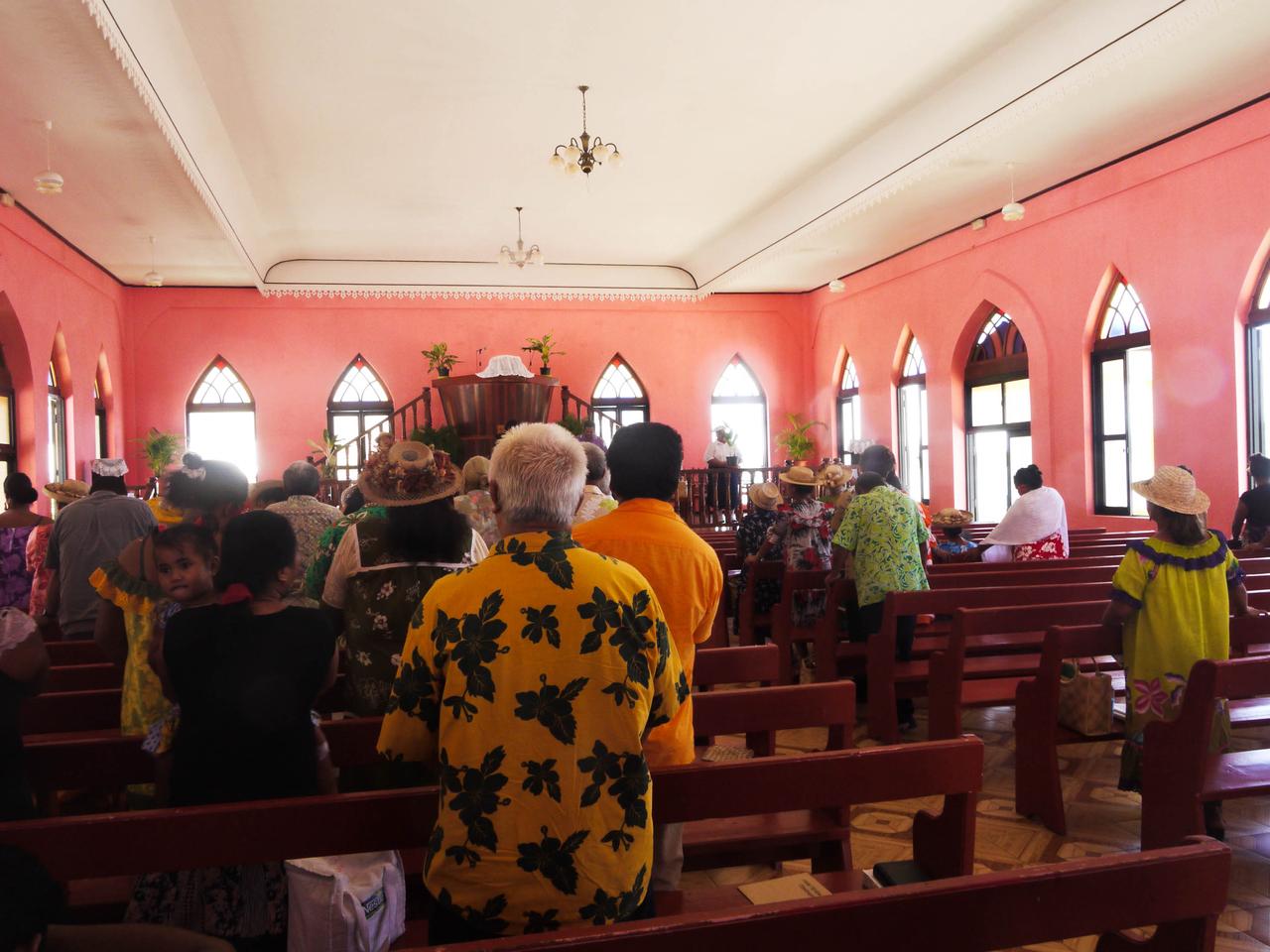 Sunday service, Huahine
Sunday service, Huahine
People come to French Polynesia primarily for one of two reasons. Either they are French speakers who like the idea of a French speaking island (this is the largest group of visitors), or they are seeking a place that is modern and exotic at the same time.
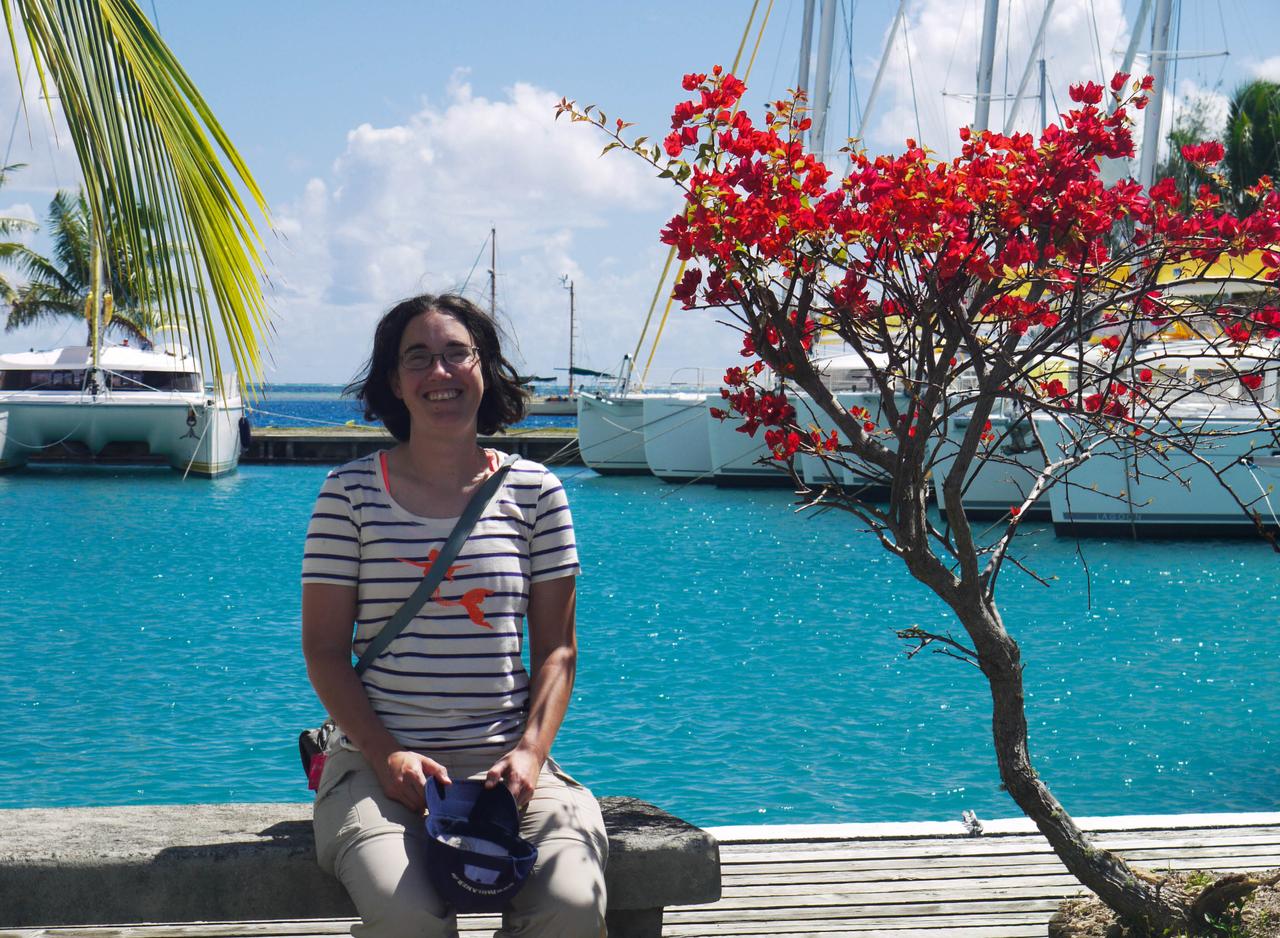 Apooiti marina, Raiatea
Apooiti marina, Raiatea
The locals, on their part, are not really itching to flood their country with as many tourists as possible. Their status as a French overseas country (pays d’outre-mer) means they are not too dependent on income from tourists to support their lifestyle - in fact tourism is often seen as interfering with that lifestyle, as hotels tend to be built in the best spots, which the islanders would rather keep for their own use. The growing resistance to hotels, along with the 2008 economic crisis, have claimed some of the country’s best resorts, turning them into tourism wastelands.
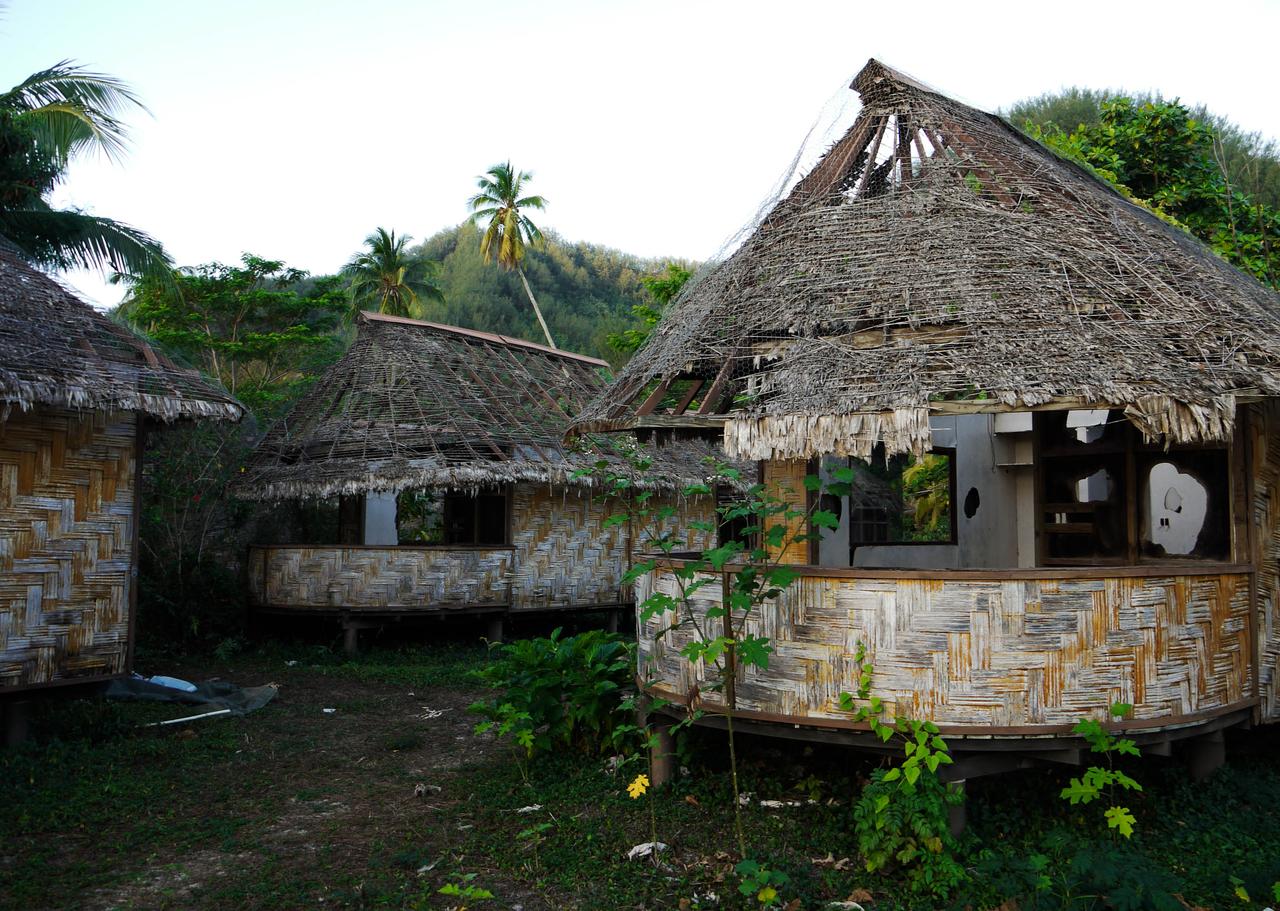 Abandoned Club Med site, Mo’orea
Abandoned Club Med site, Mo’orea
That is not to say that Tahitians are unkind to visitors - the welcome we received as international tourists was warm and generous everywhere. French nationals occasionally have to deal with some hostility, since the French-Tahitian relationship remains complicated.
A note on trash - we are pretty sensitive to strewn garbage, and were happy to find the litter situation to be firmly under control. Most places we went to were trash-free, and the remainder were clean enough to not be unpleasant. This despite no evidence of heroic cleanup efforts by the government, or public-awareness campaigns against littering. There isn’t even much of a recycling infrastructure - sadly there is a lot of garbage generated on the islands, but at least people do not see fit to dump it all over the landscape.
Lifestyle
Thoroughly modern and heavily westernized, Tahitians (which is the name for Polynesians throughout the Society archipelago, not just in Tahiti) are taking a healthy approach to their national identity. French colonial rulers spent a century trying to suppress Tahitian culture and language, and the British who came before them were not much better. Attitudes changed abruptly in the 1970’s, and Tahitian culture is making a huge comeback.
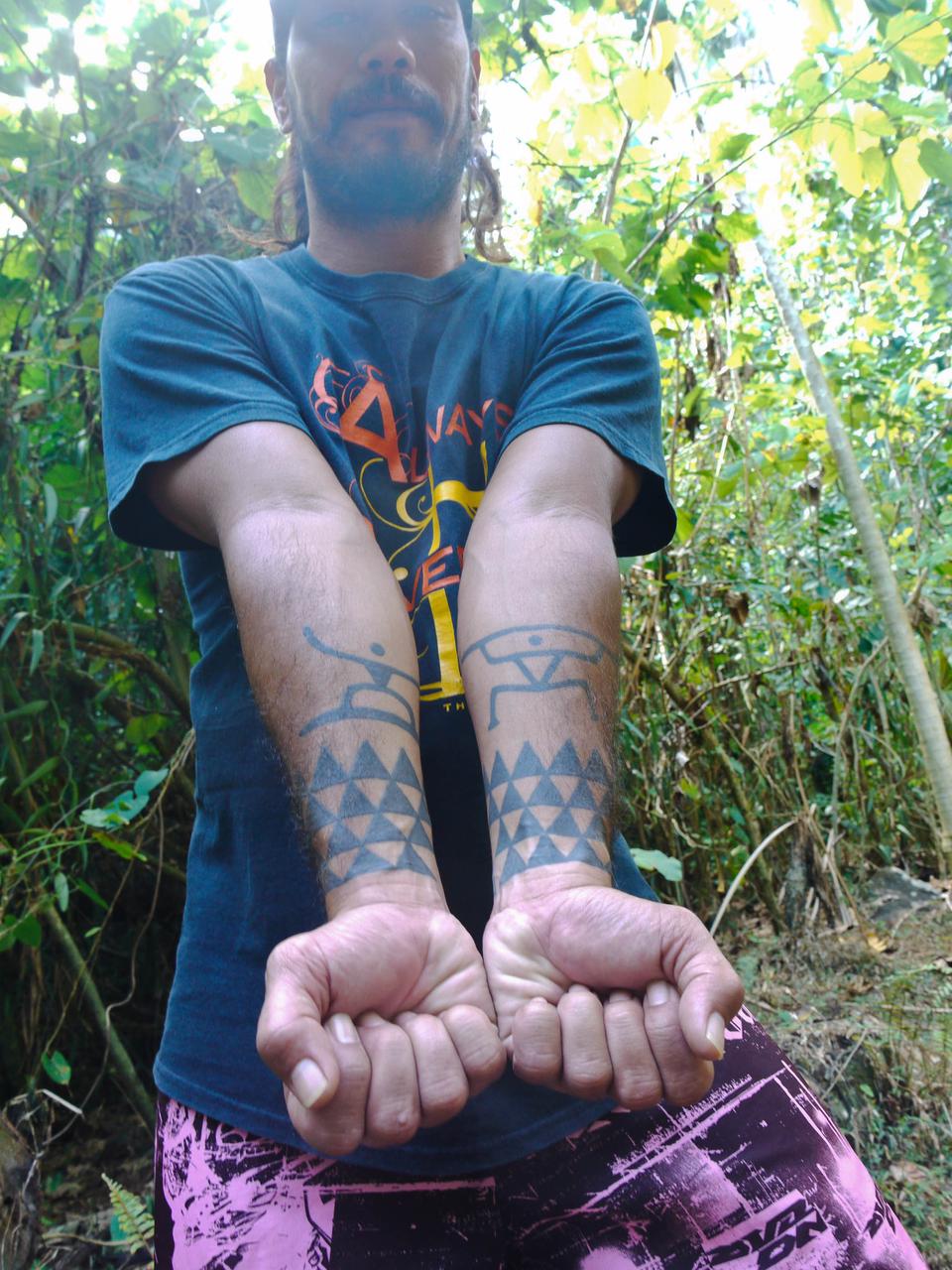 Tepaiaha shows off his tattoos, Huahine
Tepaiaha shows off his tattoos, Huahine
Rather than rejecting and trying to roll back the changes brought about by European contact, French Polynesians are putting together the sum of their influences to construct something new and better. When they decorate themselves with full-body tattoos, they adopt the latest techniques and designs from the Marquesas and New Zealand, not just the styles that were available in pre-contact Tahiti. And when they race outrigger canoes on the lagoon, the canoes are made of fiberglass, because it is so much faster and more practical than wood bark.
In their leisure time (of which there is plenty), Tahitians hang out on the beach, or cruise around the lagoon, or go surfing or fishing, or roam around the island. These happen to be the same activities that visitors engage in when they come to the islands, meaning visitors are much better integrated with local society than when they pursue the same things in (say) rural Central America, where leisure-time activity often consists of sitting outside your house and staring into space.
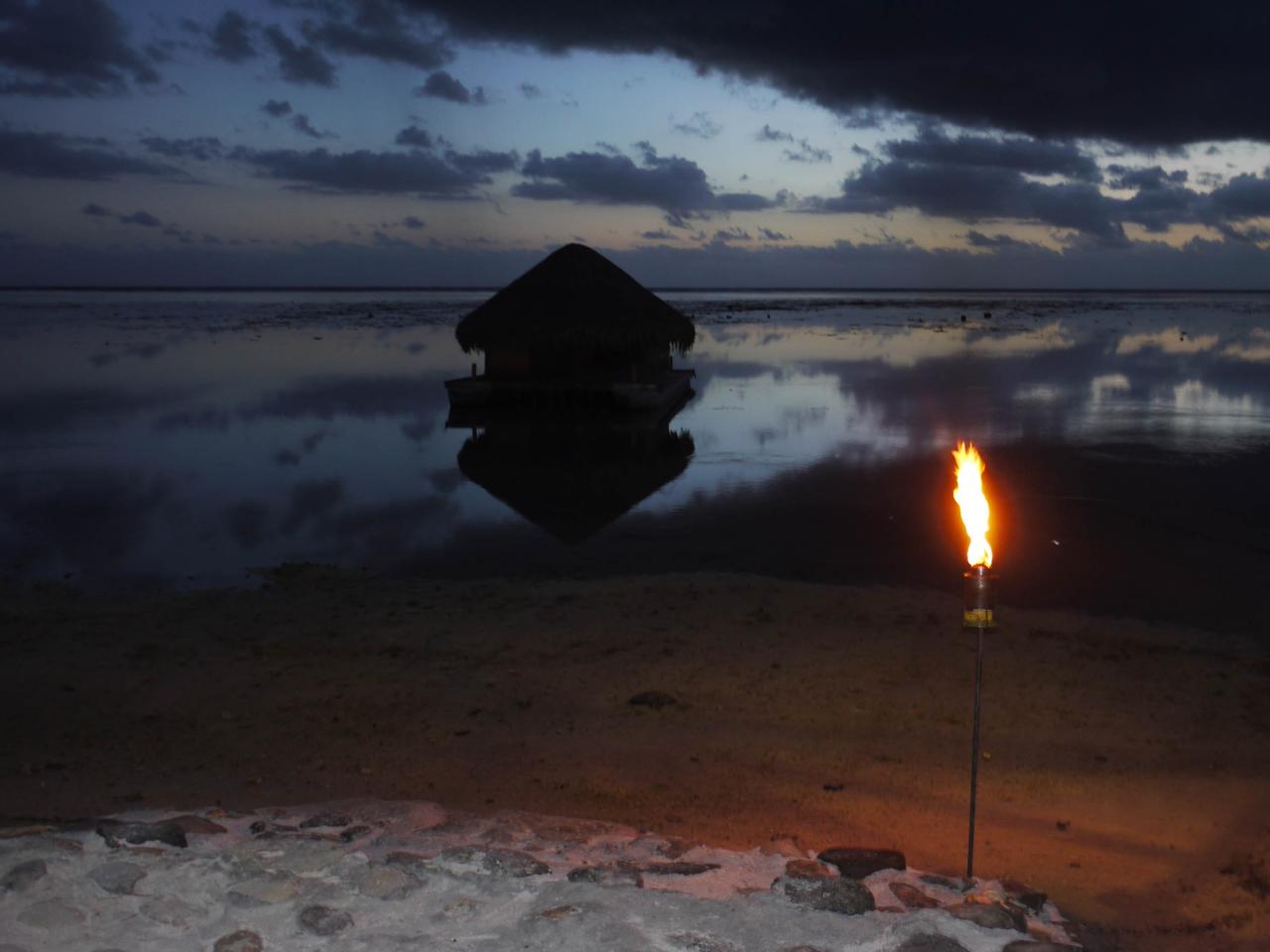 Tiki Village, Mo’orea
Tiki Village, Mo’orea
Our visit overlapped with the 2013 FIFA Beach Soccer World Cup, held in downtown Papeete. The home team, known as Le Tiki Toa (“Tiki Power”) was doing really well, and the whole nation was glued to the games. To illustrate what kind of splash this tournament was making on the world stage, if you googled “beach soccer world cup” while it was going on, the Cup website would not even come up on the first page of results. Anyway, the tiki toa were able to beat Team USA, dispatched Argentina in the quarter finals, were defeated by champions Russia (yes, Russia) in the semifinal, then tied 7-7 with Brazil in the third place match.
Food
At the supermarket on Mo’orea, almost everything in the produce aisle was imported. The only local fruit on offer was a dark-orange banana labelled “fei”. We wondered whether it’s one of those bananas that need to be cooked before eating, but when peeled it was soft and delicious with a kind of bubble gum flavour to it. When we came back for more the next day, the cashier helpfully pointed out that fe’i should be cooked before eating... We have to insist that the convenion is wrong here - although cooked fe’i is tasty, raw fe’i is possibly even better, and no ill effects were observed from eating it that way.
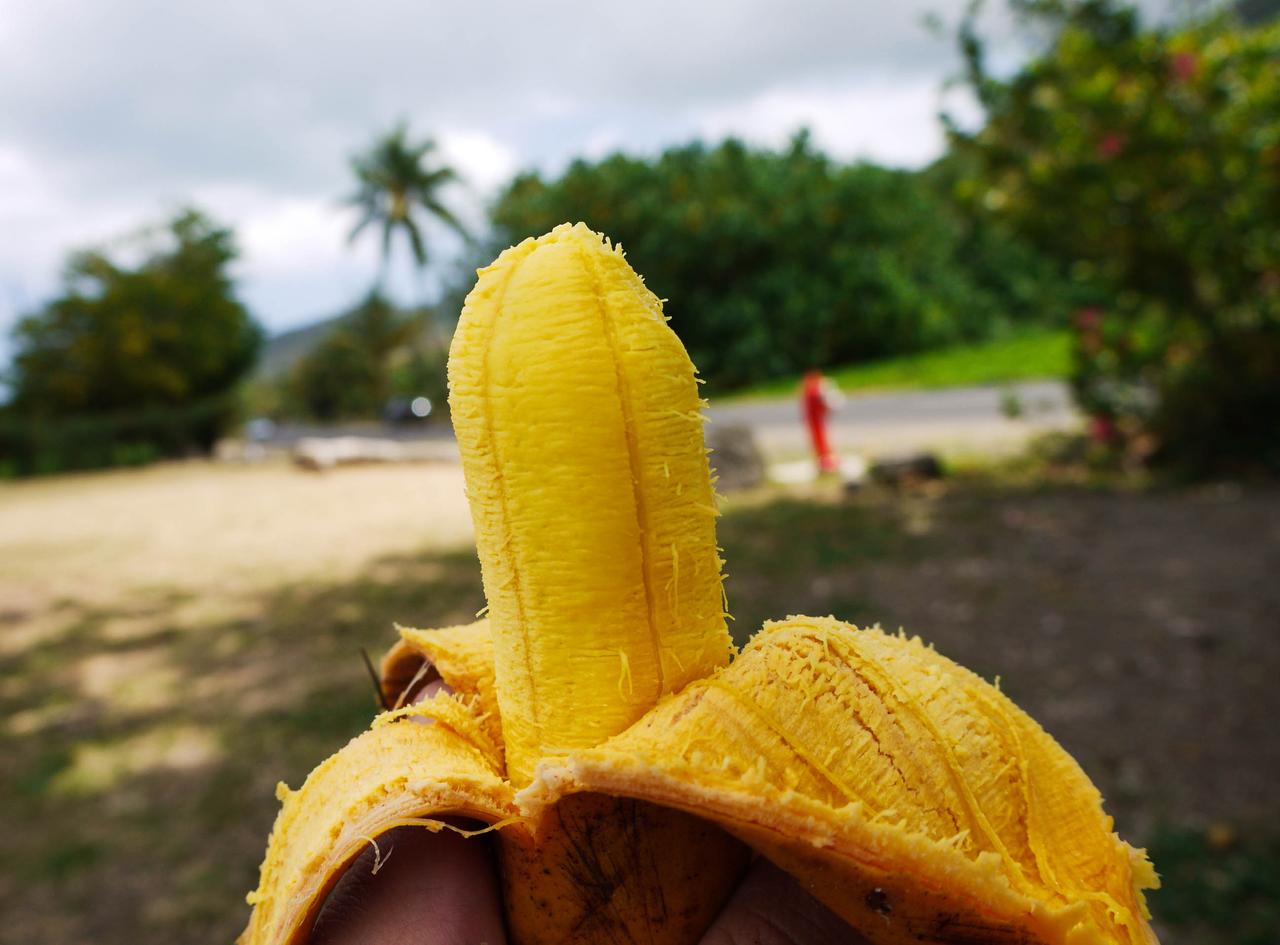 Fe’i, Mo’orea
Fe’i, Mo’orea
More interesting than the supermarket were the roadside stalls, whose selection includes uru (breadfruit), jackfruit, bananas (fe’i as well as the local eating banana, which turns a deep purple when cooked), papaya, taro, mango, noni, pineapple (called painapo in Tahitian - the fruit is a British import), and one surprise that we had never heard of - pomme etoile (star apple). Also known as milk fruit, this round purple fruit oozes a white juice when poked. The taste is… very tropical, sweet and aromatic.
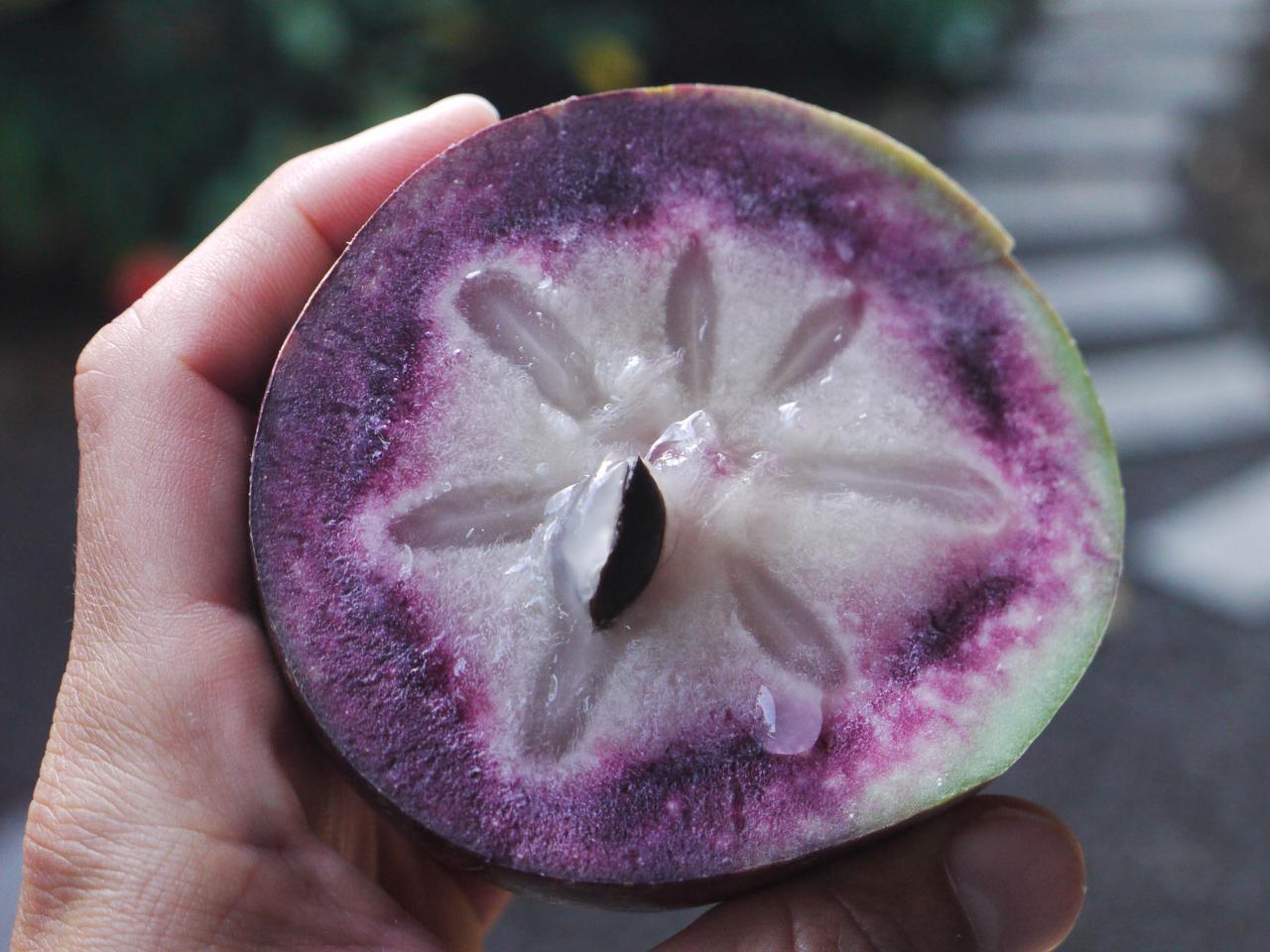 Pomme etoile, Huahine
Pomme etoile, Huahine
According to the guidebooks, the most popular dish in the islands is poisson cru, a delicious raw fish salad that lies somewhere between sashimi and ceviche (but closer to sashimi). We ate poisson cru as often as possible, but according to our observations the real national dish in the islands is - pizza. On the major islands, decent pizzerias are everywhere. Curiously, some make their pizza with olives by default - an implicit topping that goes in along with the toppings actually listed. This certainly wouldn’t fly in North America, where many people dislike the taste of olives. It is doubly strange because olives cannot grow in French Polynesia. In addition to the pizzerias, grocery stores often have a shelf with slices of ready-to-eat, plastic-wrapped, sad-looking pizza to go.
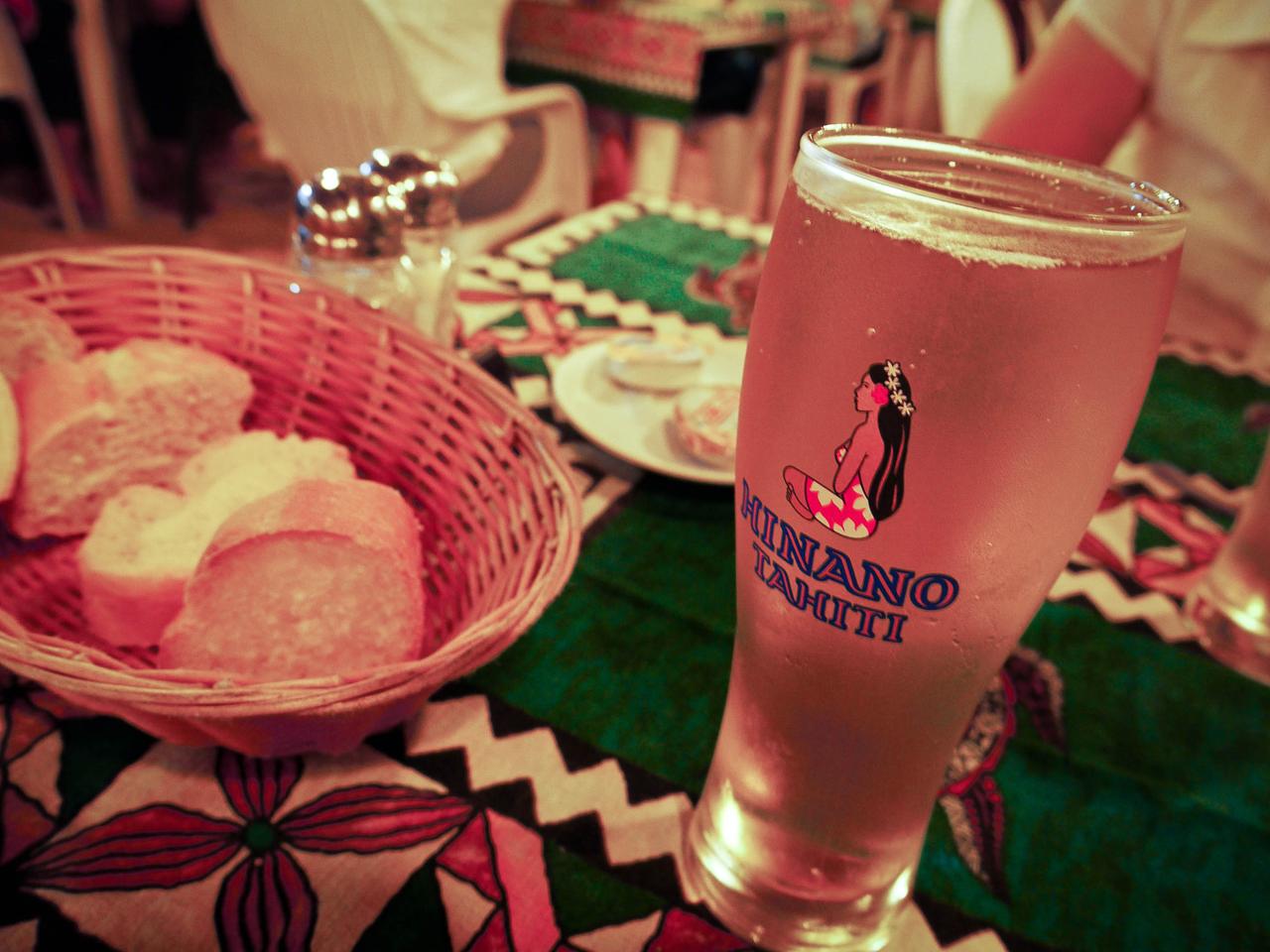 Hinano “sulphur beer”
Hinano “sulphur beer”
As for booze, the most common is Taihiti’s famous Hinano lager. The first time we ordered Hinano, the draft pints had an overpowering sulphur smell… it was too disgusting to finish. Fortunately this turned out to be just a bad batch (at first we worried this was how people liked their beer around here). Brewed correctly, Hinano is certainly drinkable, if not terribly exciting.
One lesson we learned was that buying someone a drink in the islands is not always the innocuous gesture it is in Canada. Some Polynesians do not handle their liquor very well. In the best-case scenario, they will politely refuse the offer in order to avoid a steep downward spiral.
Our favourite aspect of the French Polynesian food scene was being able to walk into any grocery and come out with a fresh baguette and a nice French cheese for around four dollars. Almost all our lunches followed the baguette-and-cheese template, alternating between tomme, camembert, and provolone. Good luck trying this on any other Pacific island.
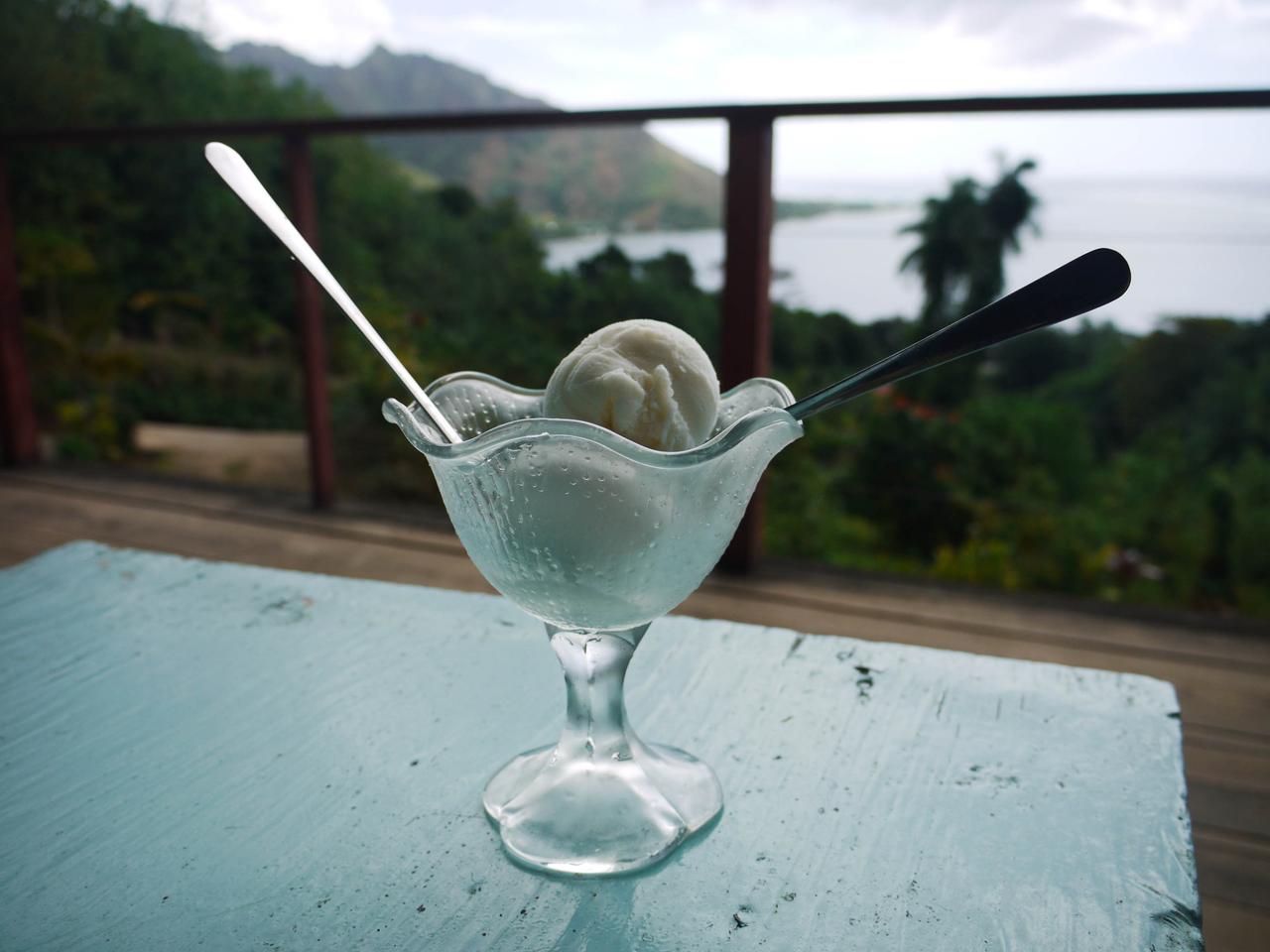 Artisan ice cream from tiare tahiti petals, Mo’orea tropical garden
Artisan ice cream from tiare tahiti petals, Mo’orea tropical garden
Costs
A table of our in-country costs (for two people, in Pacific Francs and Canadian Dollars) is shown below. However, it means little without the context, so here is some context:
- On Tahiti we stayed at the Radisson Plaza and paid with loyalty points that Dana had accumulated. Which was nice, because even basic accommodation on Tahiti can cost 200 CAD/night. Most incoming visitors are just trying to get off the island as fast as possible and go somewhere nicer, but flight schedules from North America mean an overnight stay is usually unavoidable.
- Mo’orea was the only place where we had rented a car for the duration of our stay. It was also the only place where we paid to stay in a small hotel, with a reception desk and all, as opposed to a pension. Add a visit to Tiki Village and some nice restaurant dinners, and that is how we ended up paying roughly twice per night on Mo’orea compared to the other islands.
Aside from Bora Bora, Mo’orea is the country’s only really touristy island, so if you intend to seek out touristy things, this is the right island to do so. The 36,000 XPF we had paid for the car (including fuel) were an excellent investment - experiencing the island the way we did without it would have cost far more, if it were possible at all. - On Huahine and Maupiti, where we stayed in pensions, breakfast was included in the fee. The optional dinner was a reasonably good deal, so we mostly had dinner at the pension as well. On Mo’orea we had dinner mostly in restaurants, paying 60 CAD for a main course and a drink each. As already mentioned, lunch was baguette and cheese on all the islands.
| NIGHTS | TOTAL (XPF) | PER NIGHT (XPF) | PER NIGHT (CAD) | |
|---|---|---|---|---|
| TAHITI | 2 | 24,603 | 12,302 | 148 |
| MOOREA | 5 | 171,908 | 34,382 | 414 |
| HUAHINE | 4 | 82,459 | 20,615 | 248 |
| RAIATEA | 0 | 9,948 | - | - |
| MAUPITI | 3 | 64,877 | 21,626 | 261 |
Photo sets
- Kitsch (all islands, mostly scenery)
- Mo’orea
- Leeward (Huahine + Raiatea)
- Maupiti
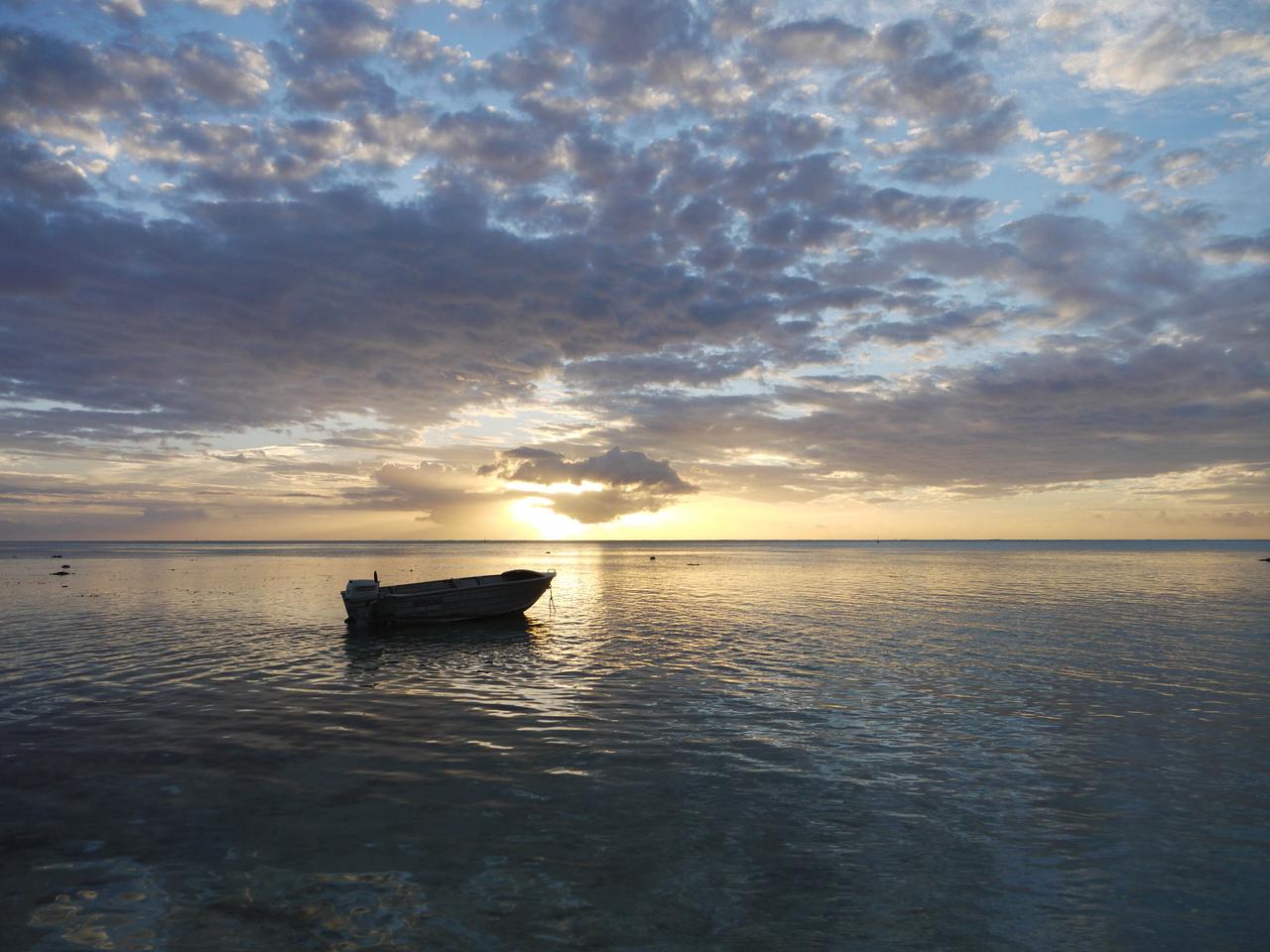 Magic sunset, Mo’orea
Magic sunset, Mo’orea

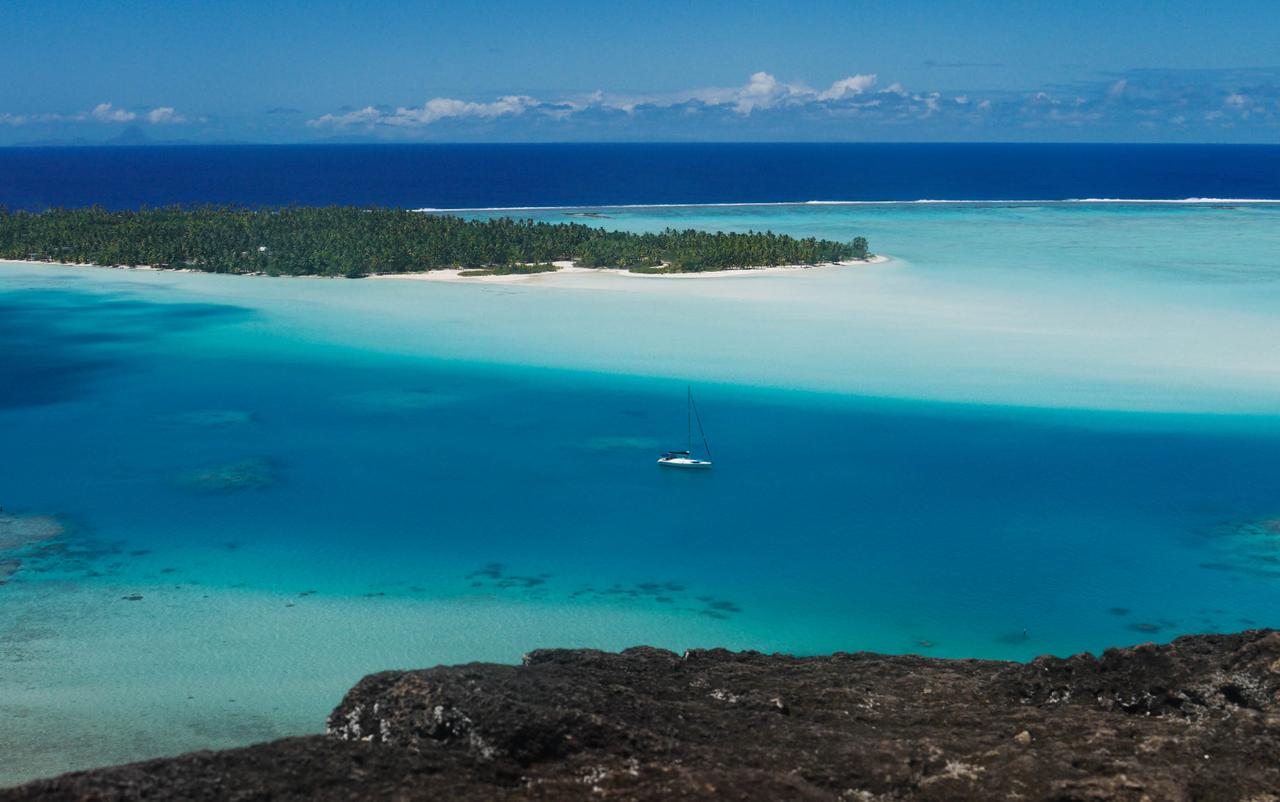
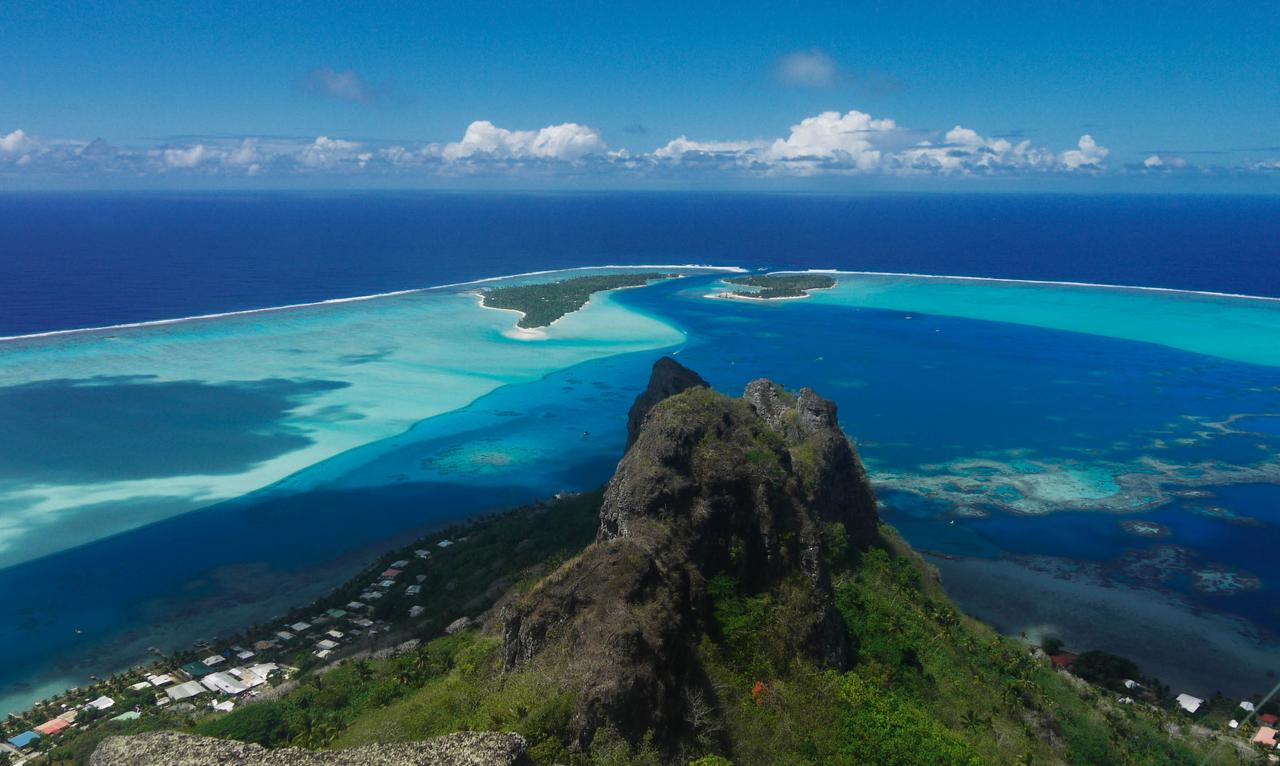
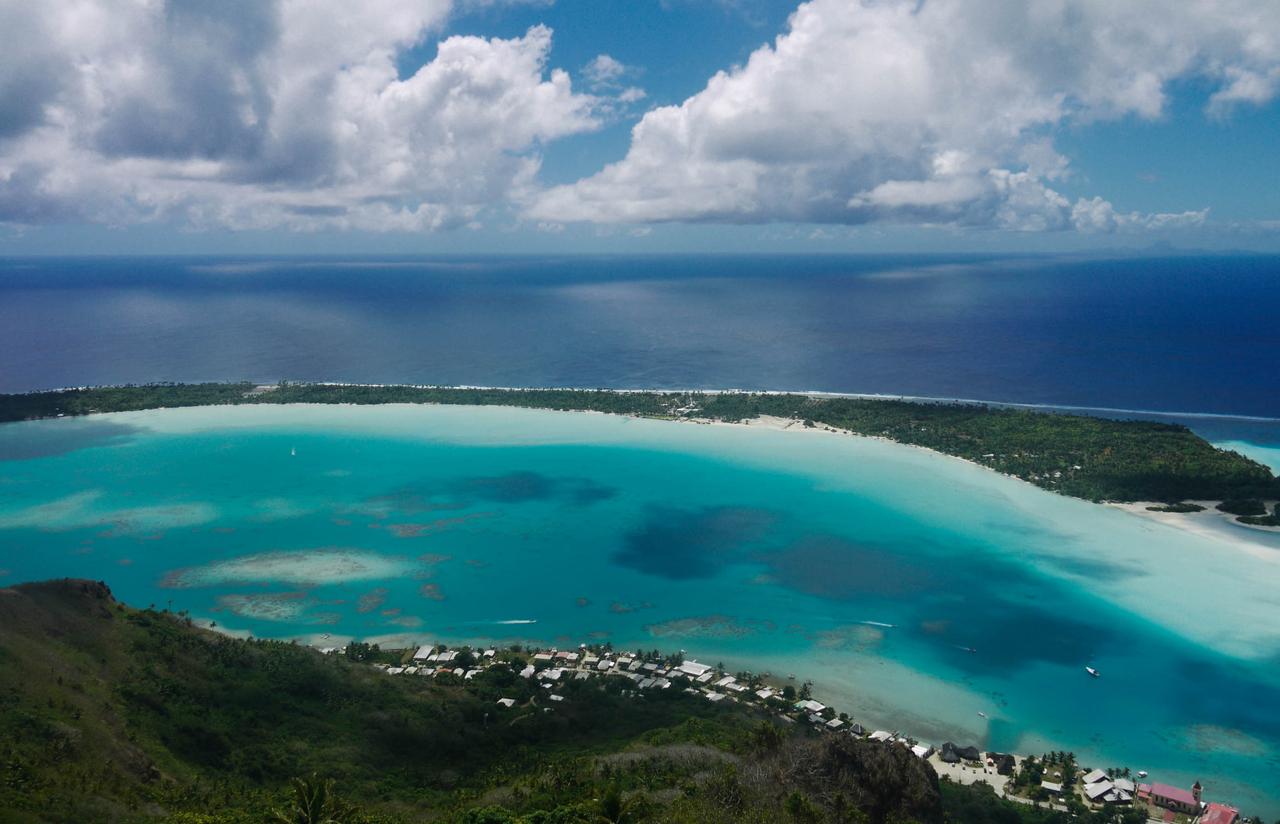
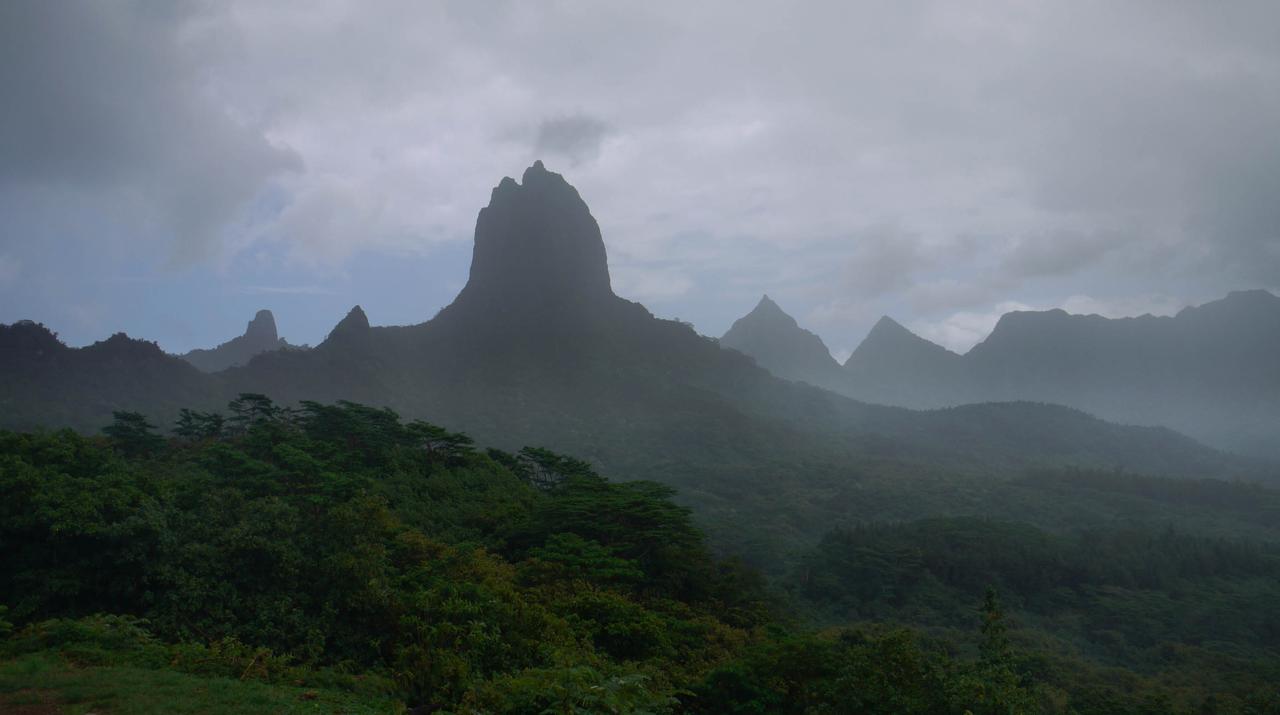
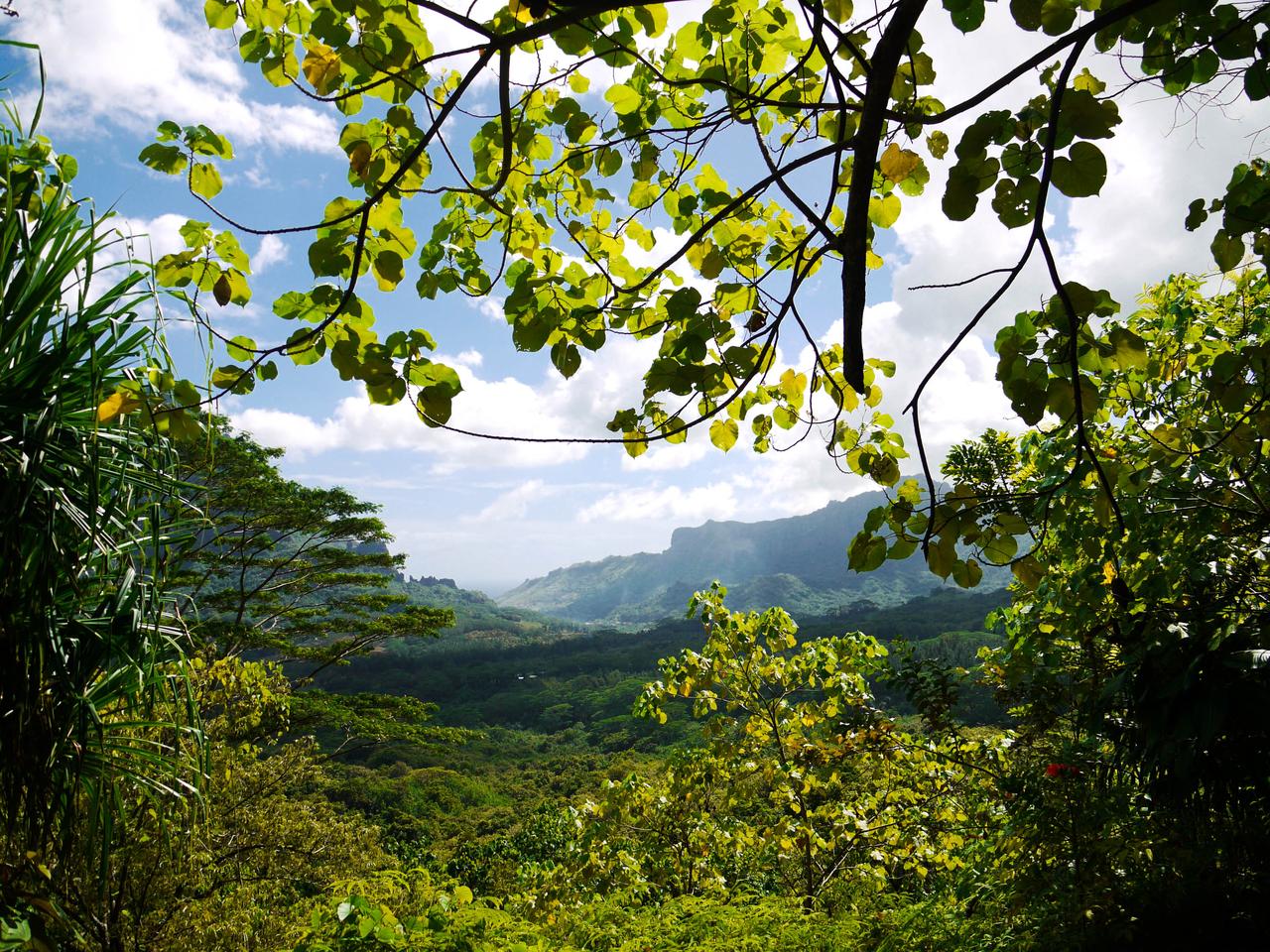
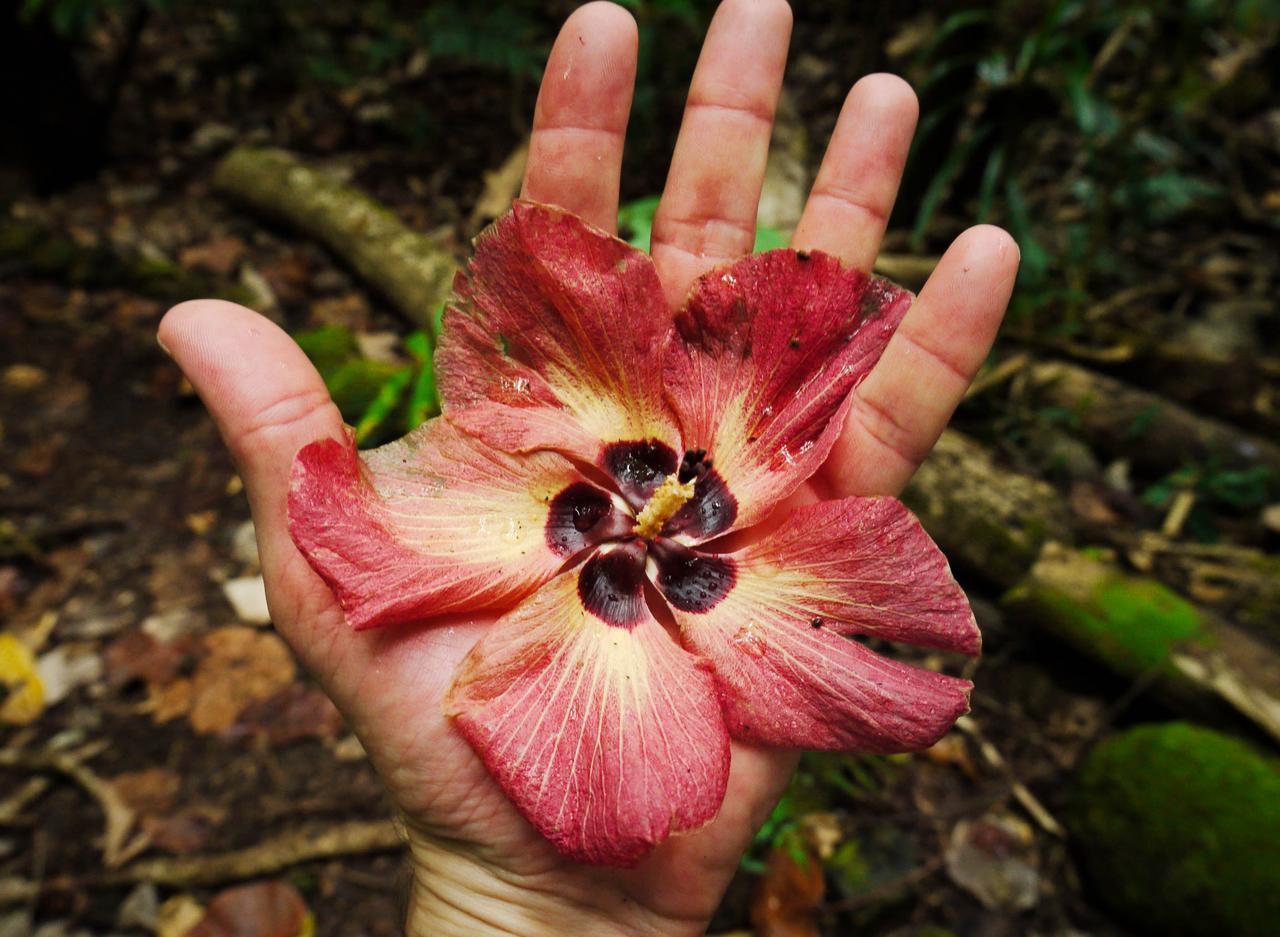
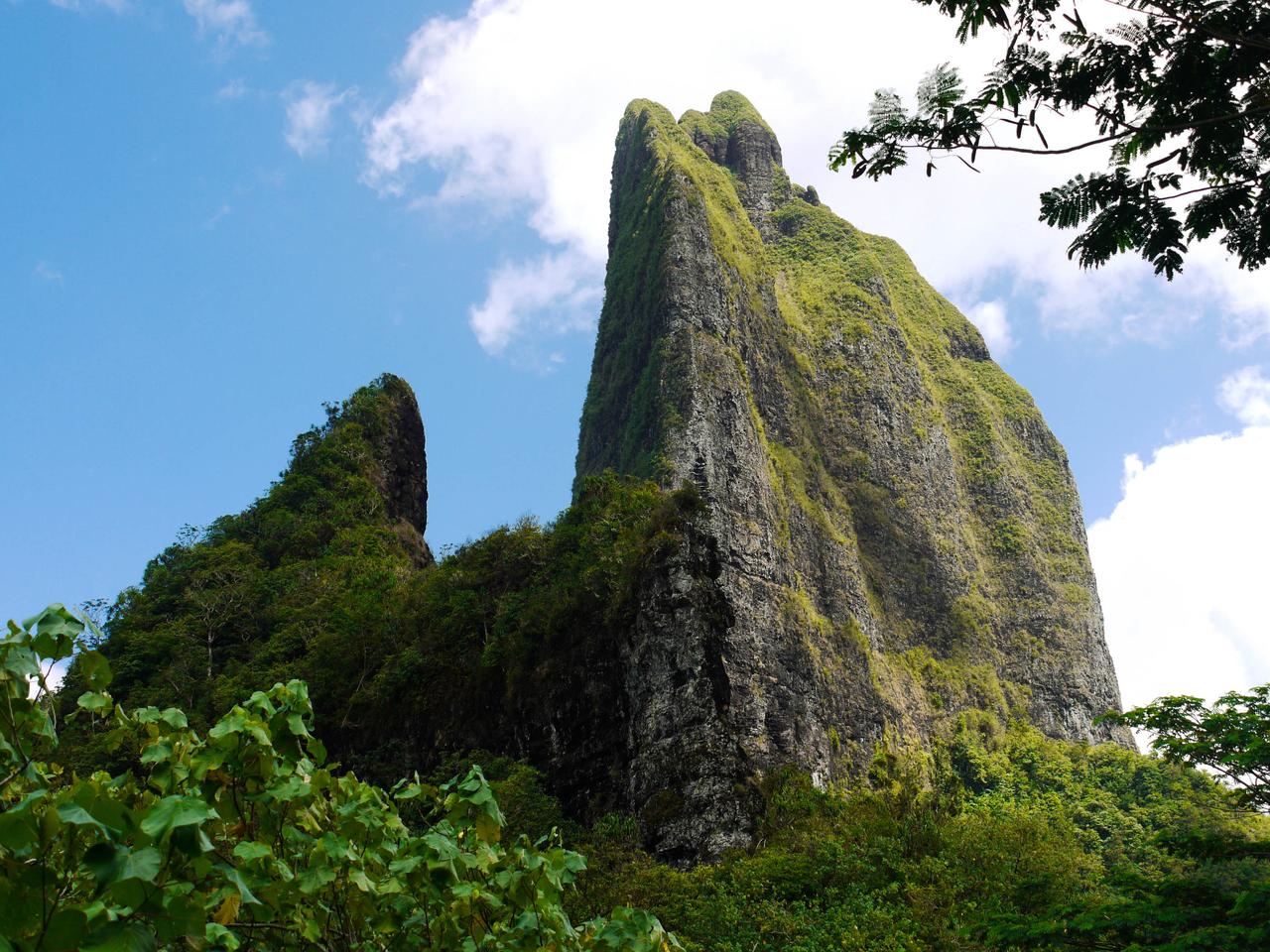
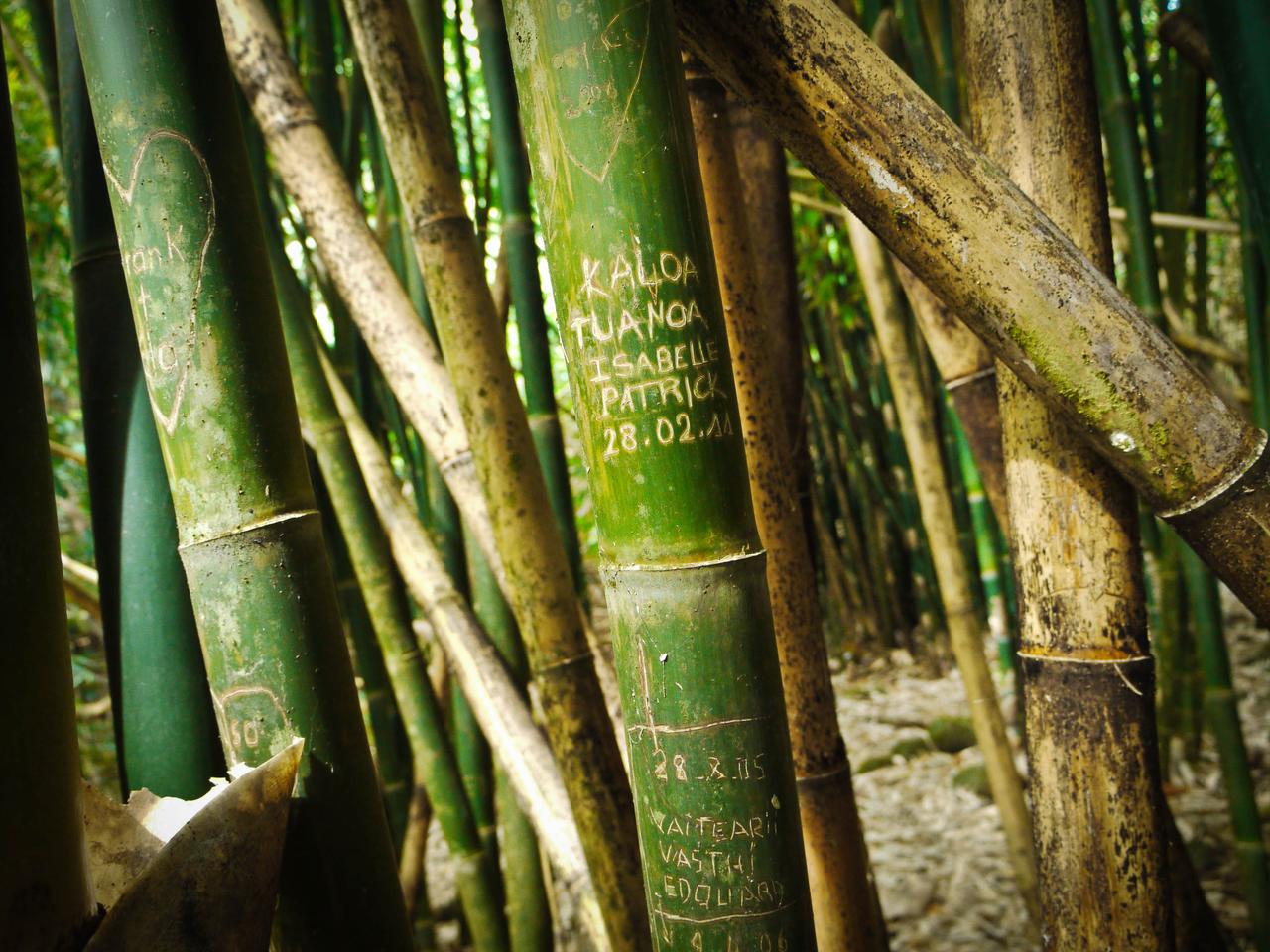
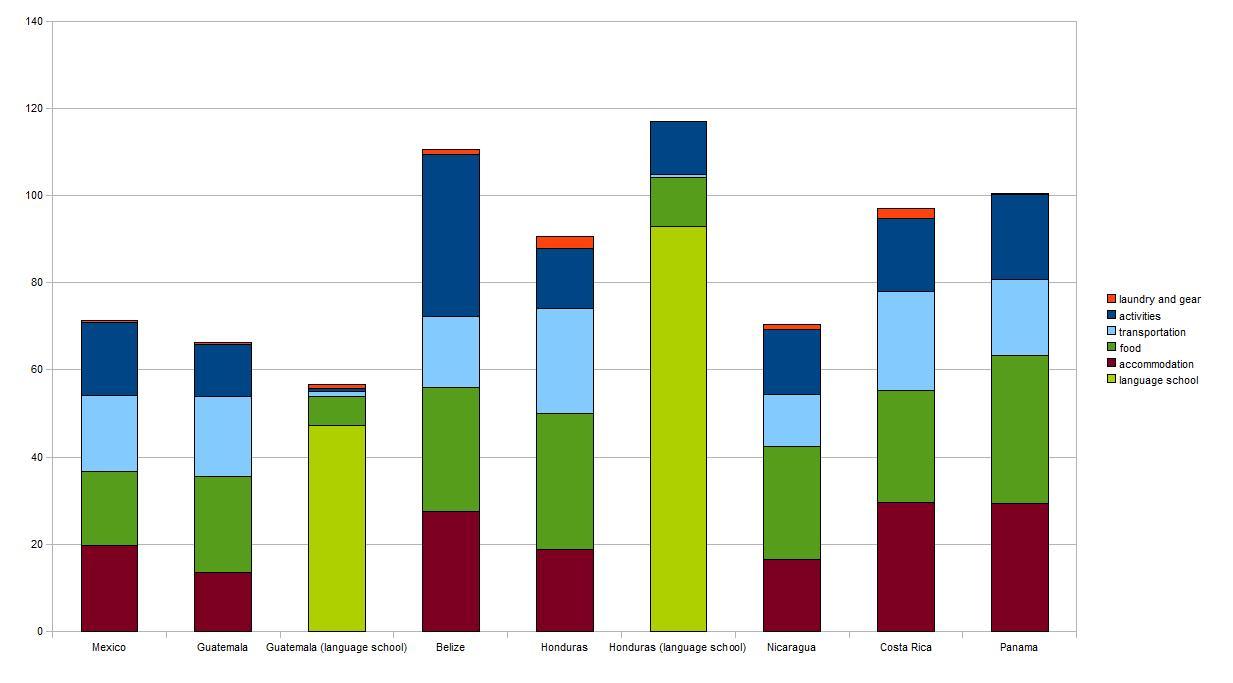 Daily budget breakdown (click for larger imager)
Daily budget breakdown (click for larger imager)